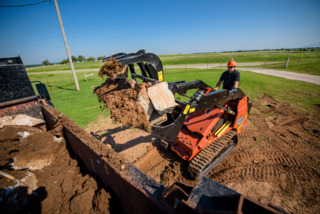Which Mini Skid Steer Attachments Can Make You More Productive?
Posted by Brant Kukuk on 23rd Dec 2024

A key benefit that stand-on skid steers bring to your fleet is their versatility. The machines can be quickly outfitted with a range of attachments, allowing them to serve as multi-functional workhorses that can take on just about any general construction or landscaping job.
However, with so many attachment options available for stand-on skid steers, it can be difficult to know which ones are right for you. Which attachments, for instance, best address your unique operational needs? Which attachments can help your people be more productive and efficient? Or maybe which attachments can open the door for your business to new jobs?
Some answers to these questions can be gleaned from learning about the most popular stand-on skid steer attachments and how they can improve job-site performance.
Trencher
Dedicated trenchers will always have a place in underground construction. But today, many utility and landscaping contractors are finding that stand-on skid steers with trencher attachments can be an efficient alternative.
The biggest appeal of a stand-on skid steer with a trencher attachment is that it can eliminate the need for a second machine on a job site.
This means you no longer need to spend time and effort transporting and maintaining a second machine, saving you money and giving you back valuable minutes in your day. Also, reducing the number of machines in your fleet allows you to reduce training. As a result, new employees have fewer machines to learn and can start contributing to jobs faster.
Stand-on skid steer trencher attachments are typically available in 4-, 6- and 8-inch widths. They can be used for a variety of installations, from utilities and fiber to irrigation and drainage systems.
Grapple Bucket
A grapple bucket is similar to a standard bucket, but it has hydraulic clamps. This allows crews to use it to hold unstable materials, like bricks, boulders, tree branches and stumps.Ditch Witch
Buckets are one of the most popular attachments for stand-on skid steers. With their ability to safely lift, carry and place large piles of materials or debris that need to be relocated or removed from a job-site, these attachments excel at helping smaller crews work efficiently.
A grapple bucket is similar to a standard bucket, but it has hydraulic clamps. This allows crews to use it to hold unstable materials, like bricks, boulders, tree branches and stumps.
If a crew needs to move a large and heavy tree branch, for instance, they can use a full-size stand-on skid steer with a grapple attachment to do it quickly in one trip. Otherwise, they’d likely need to spend time cutting the branch into smaller pieces and carrying those pieces by hand or fitting them into a standard bucket.
Hydraulic Power Fork
Hydraulic power forks can help you load and unload pallets and other heavy and bulky material — from trees and sod to bricks and boulders — from a trailer or truck bed.
A hydraulic power fork is another powerful attachment that can move heavy loads. It can help you load and unload pallets and other heavy and bulky material — from trees and sod to bricks and boulders — from a trailer or truck bed. It can also then move those big loads across tricky terrain on a job-site.
A key time-saving benefit of a hydraulic power fork is that operators can adjust its tines with intuitive controls on the stand-on skid steer. This eliminates the need for crews to get on and off the machine to adjust the tines manually, ultimately making them more productive and helping them move from one job to the next more quickly.
Auger
If you do landscaping or tree-care work, you’ll appreciate how an auger attachment can help save time on jobs.
The attachment can more quickly open holes in the ground than if you’re hand-digging or using a handheld auger. This can help you speed up tasks like tree, fence, and deck-post installations, allowing you to take on more jobs in a day and increase your ROI.
Auger attachments are available in a variety of bit styles. Sizes typically range from 6 to 36 inches.





